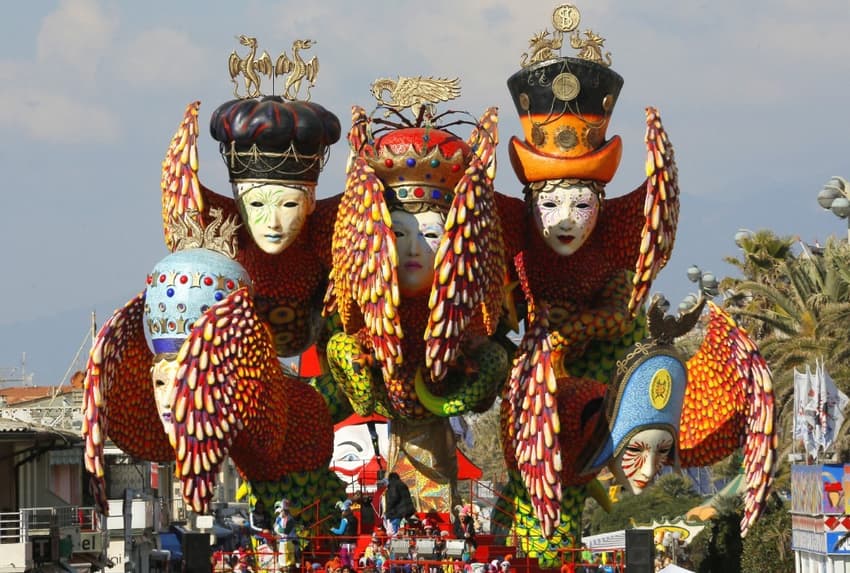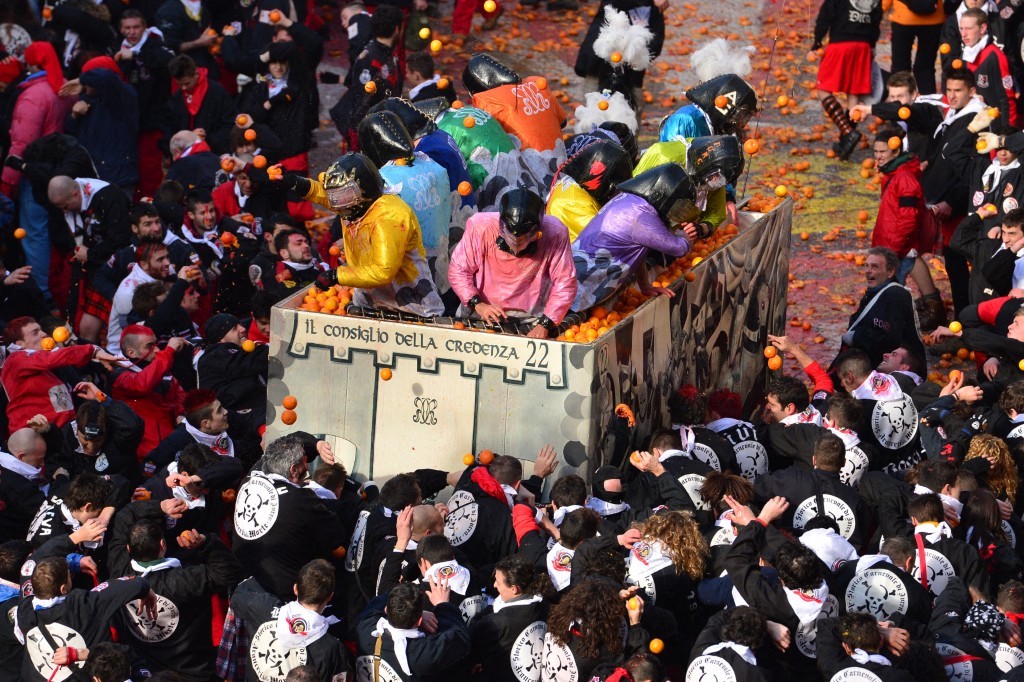Beyond Venice: Eight other carnivals to visit in Italy in February 2024

Carnival season brings some much needed colour, fun and festive spirit into the dreary month of February - and it's not only in Venice.
While Venice's Carnevale is famous the world over, there are numerous other carnival celebrations across the Italian peninsula that are equally worth visiting.
From Sicily to Sardinia, Tuscany to Marche, we've gathered some of the alternative Italian carnivals that we think are most worth your time.
The dates listed below are when you'll be able to see the parades that are the main event, but most carnivals also host a range of related events throughout the month of February.
These might include anything from papier-mâché and mask-making workshops to musical performances and food stalls: check out the programmes below for more details.
Fano - February 4th, 11th
Fano's is the sweetest of all the festivals, as chocolates, sweets and sugared almonds are thrown from the float wagons into the crowds of spectators.
It dates all the way back to 1347, making it one of Italy's oldest carnivals, and is thought to have originated as a celebration of a reconciliation between two warring local families.
READ ALSO: Wine, masks and debauchery: How did Italy’s Carnival tradition begin?
If you prefer sweet spectacles to tastes, in the last parade the floats are traditionally lit up with luminarie, making them particularly impressive to look at.
More information here.
Viareggio - February 3rd, 8th, 11th, 13th, 18th, 24th
In Viareggio's masked parade, hundreds of colourful papier-mâché floats up to 70 feet high are carried along the Tuscan seafront to music and dancing.
It started out in 1873 as a protest at the upper classes not having to pay taxes and continues to provide political and social commentary today – expect to see papier-mâché caricatures of politicians and celebrities atop the carnival floats.
More information here.

Viareggio's carnival draws spectators from all over Italy. Photo by FABIO MUZZI / AFP.
Cento - February 4th, 11th, 18th, 25th, March 5th
This quiet medieval town in the Emilia Romagna countryside comes to life in February when it puts on its 'Carnival of Europe' festival. Since the early 90s it's been twinned with Rio de Janeiro's carnival, with the winning floats getting to appear in the Rio parade.
Watch out for flying objects – part of Cento's tradition is the gettito, where toys and inflatable objects are thrown from the floats into the crowd. The end of the festival is marked with an unmissable fireworks show.
More information here.
Sciacca - February 10th, 11th, 17th, 18th
Concerts, parades, plenty of food and drink and a grand ball make up the festivities at this Sicilian extravaganza, which has a friendly rivalry with Acireale.
READ ALSO: Venice Carnival: What to expect if you’re attending in 2024
It's thought to date back to Roman times, and the highlight is on the final day when the chariot of Peppe Napa, the Carnival King is burned in the town's main square.
More information here.
Ivrea - February 4th, 8th, 10th-13th
Looking for something more exciting than your average parade? In Ivrea, the highlight of the festivities is the annual orange fight – a rather messy way of commemorating the local people's struggle against the city's tyrant and, later, against Napoleonic troops.
Those on foot represent the townspeople while those on carts play the part of the troops, all throwing oranges at each other. The epic battle lasts three days - this year, the 11th to the 13th - at the end of which awards are bestowed on the winning teams.
More information here.

Teams throw oranges at each other during Ivrea's "battle of the oranges". Photo by GIUSEPPE CACACE / AFP.
Acireale - February 3rd, 4th, 10th, 11th
Acireale’s festivities once involved locals throwing rotten eggs, oranges and lemons at each other in the street - but luckily for 21st century visitors, the custom was banned in 1612.
These days it's a much more respectable affair: as well as papier-mâché caricatures of public figures, you can expect to see elaborate flower and light displays.
If you miss the February festivities, Acireale's carnival is so popular it usually returns for a few weeks in July and August.
More information here.
Putignano - February 4th, 11th, 13th, 17th
Putignano's carnival is one of Europe's oldest, dating back to 1394 when the relics of Saint Stephen were transported to the town to protect them from Saracen raids, and locals downed tools to join the procession and celebrate.
This is also one of the longest-running carnivals in Europe, technically starting on Boxing Day and traditionally ending on Shrove Tuesday, when a papier-mâché pig is carried through the streets and then burned. Concerts, shows, and various parades all feature.
More information here.
Tempio Pausania - February 8th-13th
Spanning six days, the Carrasciali Timpiesu carnival in Tempio Pausania is one of Sardinia's most important, with cultural roots that date back to ancient times.
It starts with the triumphal entrance of King George, a straw puppet formerly known as Jolgliu Puntogliu. For several days, the king plays a central role in the general festivities and merriment, then on Mardi Gras he's put on trial for all the town's ills and burned at the stake.
More information here.
Comments
See Also
While Venice's Carnevale is famous the world over, there are numerous other carnival celebrations across the Italian peninsula that are equally worth visiting.
From Sicily to Sardinia, Tuscany to Marche, we've gathered some of the alternative Italian carnivals that we think are most worth your time.
The dates listed below are when you'll be able to see the parades that are the main event, but most carnivals also host a range of related events throughout the month of February.
These might include anything from papier-mâché and mask-making workshops to musical performances and food stalls: check out the programmes below for more details.
Fano - February 4th, 11th
Fano's is the sweetest of all the festivals, as chocolates, sweets and sugared almonds are thrown from the float wagons into the crowds of spectators.
It dates all the way back to 1347, making it one of Italy's oldest carnivals, and is thought to have originated as a celebration of a reconciliation between two warring local families.
READ ALSO: Wine, masks and debauchery: How did Italy’s Carnival tradition begin?
If you prefer sweet spectacles to tastes, in the last parade the floats are traditionally lit up with luminarie, making them particularly impressive to look at.
More information here.
Viareggio - February 3rd, 8th, 11th, 13th, 18th, 24th
In Viareggio's masked parade, hundreds of colourful papier-mâché floats up to 70 feet high are carried along the Tuscan seafront to music and dancing.
It started out in 1873 as a protest at the upper classes not having to pay taxes and continues to provide political and social commentary today – expect to see papier-mâché caricatures of politicians and celebrities atop the carnival floats.
More information here.

This quiet medieval town in the Emilia Romagna countryside comes to life in February when it puts on its 'Carnival of Europe' festival. Since the early 90s it's been twinned with Rio de Janeiro's carnival, with the winning floats getting to appear in the Rio parade.
Watch out for flying objects – part of Cento's tradition is the gettito, where toys and inflatable objects are thrown from the floats into the crowd. The end of the festival is marked with an unmissable fireworks show.
More information here.
Sciacca - February 10th, 11th, 17th, 18th
Concerts, parades, plenty of food and drink and a grand ball make up the festivities at this Sicilian extravaganza, which has a friendly rivalry with Acireale.
READ ALSO: Venice Carnival: What to expect if you’re attending in 2024
It's thought to date back to Roman times, and the highlight is on the final day when the chariot of Peppe Napa, the Carnival King is burned in the town's main square.
More information here.
Ivrea - February 4th, 8th, 10th-13th
Looking for something more exciting than your average parade? In Ivrea, the highlight of the festivities is the annual orange fight – a rather messy way of commemorating the local people's struggle against the city's tyrant and, later, against Napoleonic troops.
Those on foot represent the townspeople while those on carts play the part of the troops, all throwing oranges at each other. The epic battle lasts three days - this year, the 11th to the 13th - at the end of which awards are bestowed on the winning teams.
More information here.

Acireale’s festivities once involved locals throwing rotten eggs, oranges and lemons at each other in the street - but luckily for 21st century visitors, the custom was banned in 1612.
These days it's a much more respectable affair: as well as papier-mâché caricatures of public figures, you can expect to see elaborate flower and light displays.
If you miss the February festivities, Acireale's carnival is so popular it usually returns for a few weeks in July and August.
More information here.
Putignano - February 4th, 11th, 13th, 17th
Putignano's carnival is one of Europe's oldest, dating back to 1394 when the relics of Saint Stephen were transported to the town to protect them from Saracen raids, and locals downed tools to join the procession and celebrate.
This is also one of the longest-running carnivals in Europe, technically starting on Boxing Day and traditionally ending on Shrove Tuesday, when a papier-mâché pig is carried through the streets and then burned. Concerts, shows, and various parades all feature.
More information here.
Tempio Pausania - February 8th-13th
Spanning six days, the Carrasciali Timpiesu carnival in Tempio Pausania is one of Sardinia's most important, with cultural roots that date back to ancient times.
It starts with the triumphal entrance of King George, a straw puppet formerly known as Jolgliu Puntogliu. For several days, the king plays a central role in the general festivities and merriment, then on Mardi Gras he's put on trial for all the town's ills and burned at the stake.
More information here.
Join the conversation in our comments section below. Share your own views and experience and if you have a question or suggestion for our journalists then email us at [email protected].
Please keep comments civil, constructive and on topic – and make sure to read our terms of use before getting involved.
Please log in here to leave a comment.